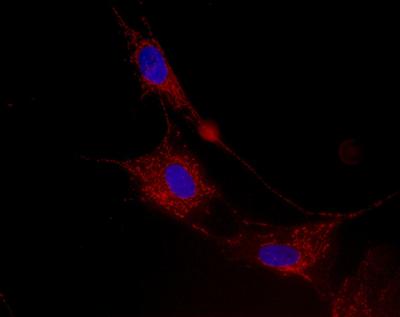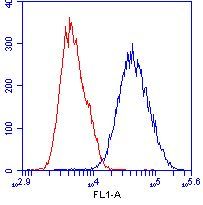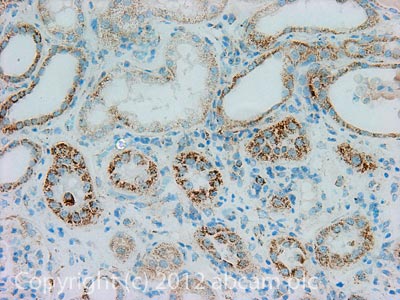![All lanes : Anti-SLIRP antibody [1E10BC8] (ab119687) at 1 µg/mlLane 1 : HepG2 lysate at 20 µgLane 2 : fibroblast lysate at 20 µg/mlLane 3 : SLIRP recombinant protein at 0.01 µgSecondaryInfra red fluorescence - Goat anti-mouse 800 at 1/5000 dilution](http://www.bioprodhub.com/system/product_images/ab_products/2/sub_5/1508_SLIRP-Primary-antibodies-ab119687-5.gif)
All lanes : Anti-SLIRP antibody [1E10BC8] (ab119687) at 1 µg/mlLane 1 : HepG2 lysate at 20 µgLane 2 : fibroblast lysate at 20 µg/mlLane 3 : SLIRP recombinant protein at 0.01 µgSecondaryInfra red fluorescence - Goat anti-mouse 800 at 1/5000 dilution

Immunocytochemistry of ab119687 stained HDFn cells (human). The cells were paraformaldehyde fixed (4%, 20 min) and Triton X-100 permeabilized (0.1%, 15min). The cells were then incubated with the antibody (ab119687, 1µg/ml) for 2h at room temperature or over night at 4°C. The secondary antibody was (red) 594 goat anti-mouse IgG (H+L) used at a 1/1000 dilution for 1h. 10% Goat serum was used as the blocking agent for all blocking steps. The target protein locates to the mitochondria.

Fibroblast (HDFn) cells were stained with 1µg/mL SLIRP antibody (ab119687) (blue) or an equal amount of an isotype control antibody (red) and analyzed by flow cytometry.

IHC image of SLIRP staining in Human normal kidney formalin fixed paraffin embedded tissue section, performed on a Leica BondTM system using the standard protocol F. The section was pre-treated using heat mediated antigen retrieval with sodium citrate buffer (pH6, epitope retrieval solution 1) for 20 mins. The section was then incubated with ab119687, 5µg/ml, for 15 mins at room temperature and detected using an HRP conjugated compact polymer system. DAB was used as the chromogen. The section was then counterstained with haematoxylin and mounted with DPX.For other IHC staining systems (automated and non-automated) customers should optimize variable parameters such as antigen retrieval conditions, primary antibody concentration and antibody incubation times.
![All lanes : Anti-SLIRP antibody [1E10BC8] (ab119687) at 1 µg/mlLane 1 : HepG2 lysate at 20 µgLane 2 : fibroblast lysate at 20 µg/mlLane 3 : SLIRP recombinant protein at 0.01 µgSecondaryInfra red fluorescence - Goat anti-mouse 800 at 1/5000 dilution](http://www.bioprodhub.com/system/product_images/ab_products/2/sub_5/1508_SLIRP-Primary-antibodies-ab119687-5.gif)


